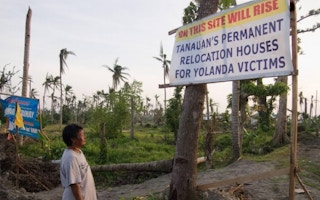Governments need to plan better for rising migration driven by climate change, experts said on Thursday, citing evidence that extreme weather and natural disasters force far more people from their homes than wars.
Projections by leading climate scientists of rising sea levels, heatwaves, floods and droughts linked to global warming are likely to oblige millions of people to move out of harm’s way, with some never able to return.
The issue is politically sensitive at a time when economic austerity is straining the generosity of host governments and anti-immigrant sentiment is rising in many countries, especially in Europe.
“Natural disasters displace three to 10 times more people than all conflicts and war in the world combined,” said Jan Egeland, head of the Norwegian Refugee Council which runs the Internal Displacement Monitoring Centre (IDMC) in Geneva.
IDMC data show that 22 million people were displaced by extreme events in 2013, led by Typhoon Haiyan in the Philippines, three times more than the number displaced by conflicts. In many other years, the ratio was much wider.
“
Natural disasters displace three to 10 times more people than all conflicts and war in the world combined
Jan Egeland, head of the Norwegian Refugee Council
In the early 1970s, the total number of people displaced was only about 10 million. Extreme events also include earthquakes and tsunamis, unrelated to the weather.
“Many more people in a growing population live more exposed to more extreme weather,” Egeland told a conference in Oslo about migration and climate change.
Chaloka Beyani, the United Nations‘ special rapporteur on the human rights of internally displaced persons, told Reuters that governments should step up planning for migrants.
“For the future we are looking more to planned relocations for people who are prone to frequent hazards,” he said.
Sea level rise of 19 cm (8 inches) since 1900, caused by factors including a thaw of glaciers from the Andes to the Alps and of Greenland’s ice sheet, aggravates storm surges in many coastal regions, according to the U.N. panel of climate experts.
The panel’s scenarios point to a further rise of 26 to 82 cm by the late 21st century. The panel says it is at least 95 per cent probable that human activities, led by burning of fossil fuels, are the main cause of warming.
“We don’t have to wait until an island sinks in maybe 50 years time and an entire population vanishes,” Beyani said. “There will have to be a planned movement and relocation.”
Climate change also added reasons for people to leave home by disrupting food and water supplies. “Access to resources, constrained by climatic factors, breeds conflict,” he said.










